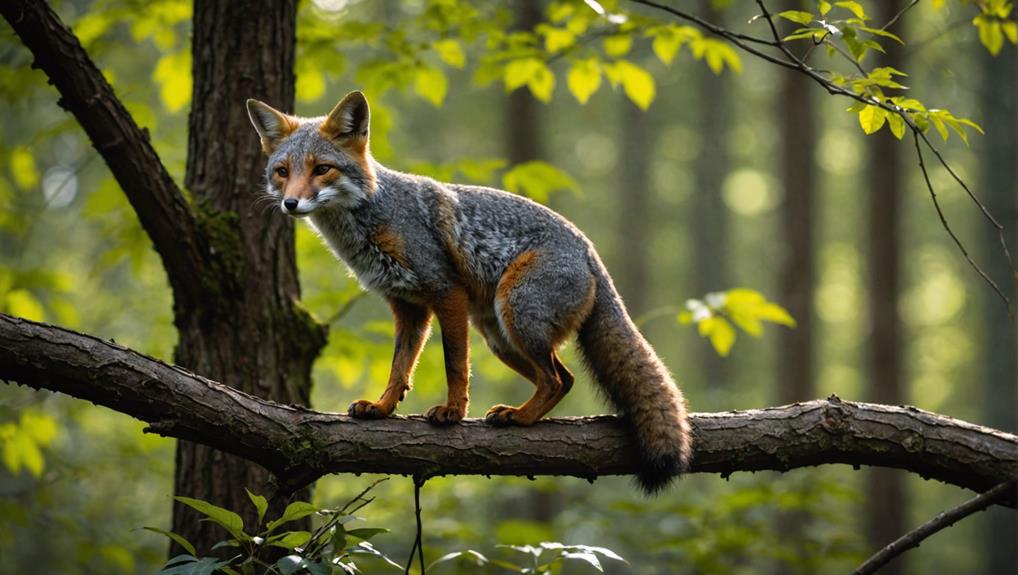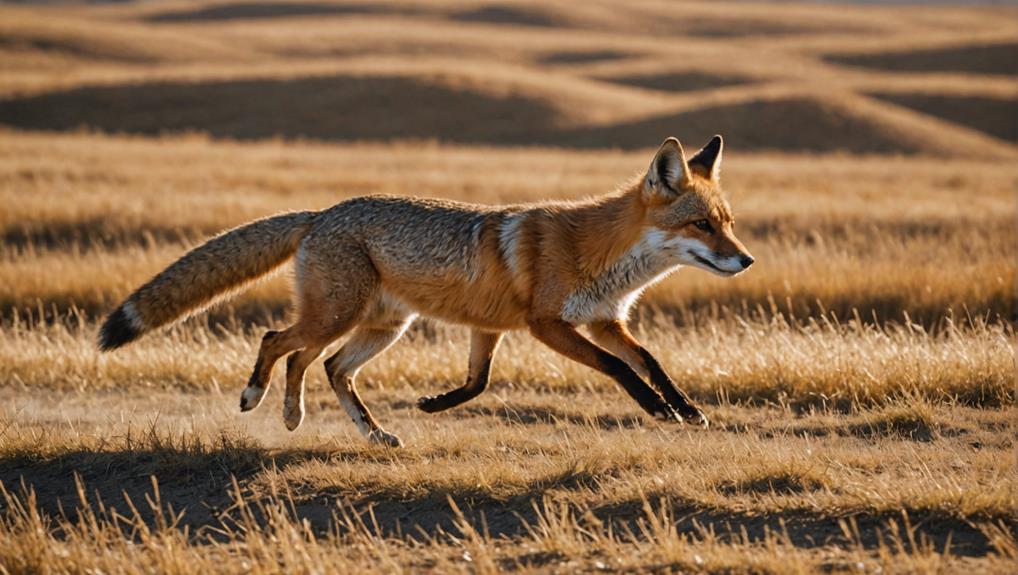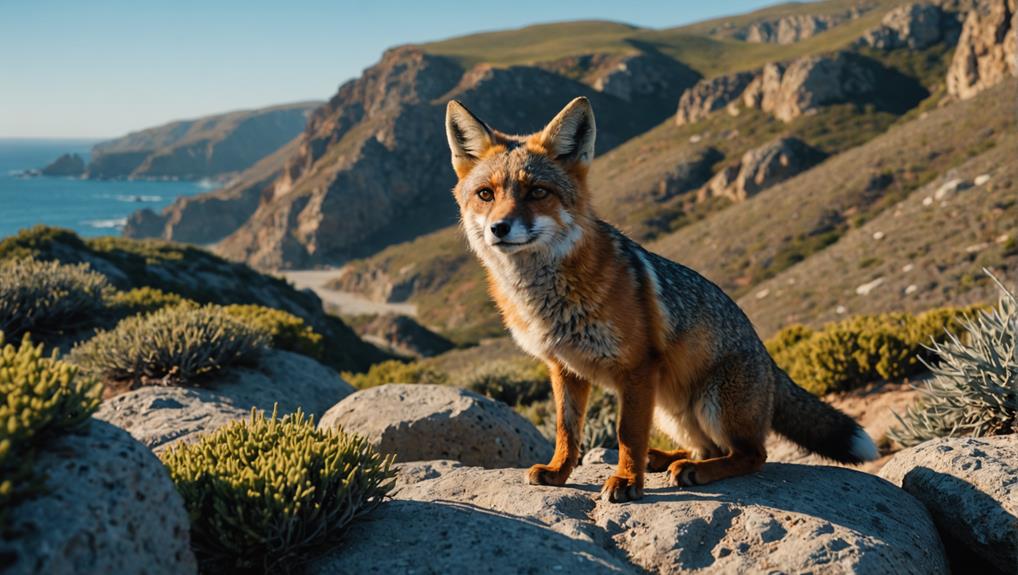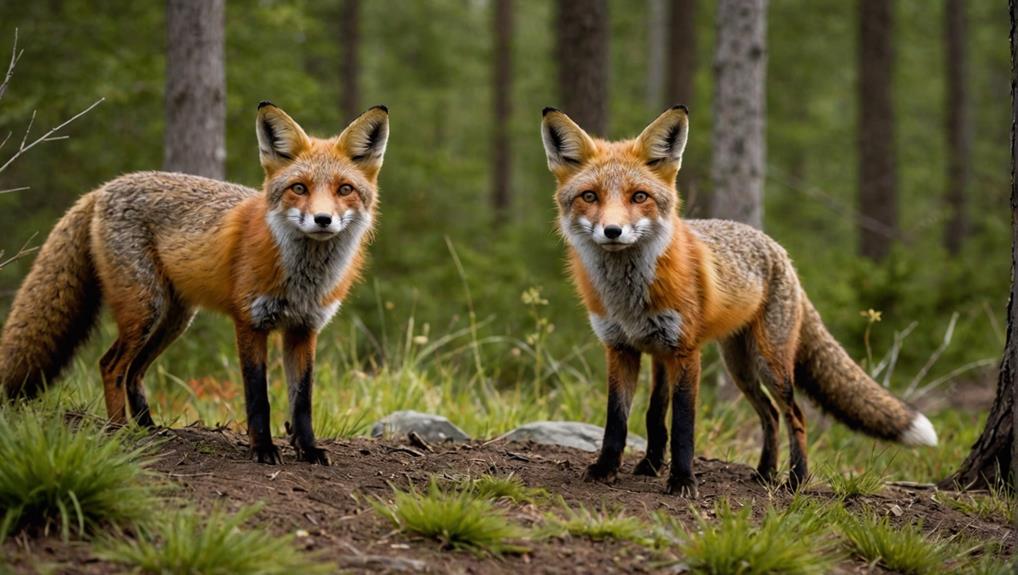If you're curious about North American fox species, you're in for a treat! You've got the widespread Red Fox, with its charming reddish coat, living just about anywhere except the southern deserts. The Gray Fox is a stealthy tree climber, while the Arctic Fox sports a thick fur coat for tundra life. Don't forget the petite Kit Fox, thriving in the desert, and the lively Swift Fox, scurrying across the prairies. Lastly, there's the Island Fox, critically endangered and only found on the Channel Islands. Each fox has its special home, and there's more to explore if you stick around!
Contents
Overview of North American Foxes
When you think about North American wildlife, the diverse range of fox species often stands out.
You've got the Red Fox, known for its striking orange-red coat and white-tipped tail. It's the most widespread fox in North America, thriving in various habitats, though it skips out on southern California, Arizona, and central Texas. This adaptable creature can be found in forests, grasslands, and even urban areas, often living near human settlements.
Then there's the Gray Fox, a sneaky little climber that prefers woodland habitats. This clever creature can ascend trees, giving it a unique edge in the wild, making it distinct among fox species notable species include.
Now, if you venture north, you'll find the Arctic Fox, perfectly designed for cold tundra. It's a master of disguise, changing its fur color with the seasons—brown in summer and white in winter—to blend into its icy surroundings.
Finally, there's the Kit Fox, the smallest of the bunch, usually weighing just 4-6 pounds. Living in desert and brushy habitats, its big ears help it hear everything, even your whispers about it!
Each of these foxes plays a vital role in their respective ecosystems, reminding us how important it's to protect their environments and the delicate balance of life in North America.
Red Fox: The Widespread Canid
The Red Fox is undoubtedly the most common fox species in North America, captivating wildlife enthusiasts with its striking appearance and adaptability. With its bushy tail tipped in white and a reddish-orange coat, the red fox stands out in various habitats.
They thrive in diverse environments, including mixed landscapes, which provide ample food sources. You'll find these agile hunters thriving in woods, grasslands, deserts, and even urban areas. It's impressive how they manage to adapt to so many environments!
Typically weighing between 8 to 15 pounds and standing about 15 inches tall, red foxes have a widespread presence across nearly all of North America, except for southern California, Arizona, and central Texas.
Their keen senses help them stalk prey like mice and rabbits, making them efficient, solitary hunters. They've got a knack for being opportunistic feeders too, munching on fruits and carrion when needed.
When you spot a red fox, you're witnessing a true survivor of the wild. Their adaptability and charm make them a favorite among those who love nature.
Gray Fox: The Tree Climber

When you think of foxes, you mightn't picture them scaling trees, but the Gray Fox definitely has that talent! This clever little creature not only uses its climbing skills to escape danger but also to hunt for tasty snacks in the branches.
As we explore their unique behaviors, habitat preferences, and foraging techniques, you'll see just how special these agile foxes really are!
Climbing Abilities and Behavior
Few creatures in North America can match the gray fox's remarkable climbing prowess. These agile animals are truly skilled climbers, thanks to their unique wrist bones that allow them to scale trees with ease. When you observe gray foxes in their natural habitat, you'll often see them darting up into the tree canopy, escaping predators or searching for tasty treats like fruits and bird nests.
Their ability to navigate wooded environments is complemented by their semi-retractable claws, which enhance their grip on branches, making them even more adept climbers. This remarkable adaptation helps them thrive in wooded habitats where they can find shelter and food, showcasing their unique habitat preferences.
Their arboreal lifestyle sets gray foxes apart from other fox species. Unlike their more grounded cousins, they prefer wooded habitats where they can climb and traverse branches between trees. This climbing ability not only helps them avoid competition with larger canids but also gives them a strategic edge in finding food and shelter.
Imagine being able to escape danger just by climbing a tree!
Gray foxes have a certain charm about them as they navigate their environment, showcasing their climbing abilities. You can't help but admire their quick, agile movements.
Habitat Preferences and Range
Gray foxes, or Urocyon cinereoargenteus, thrive in a variety of wooded habitats, including forests, shrublands, and areas with dense vegetation. This adaptability sets them apart from foxes generally.
You might find them in places like:
- Lush hardwood forests where they can hide from predators and find food.
- Thick underbrush that offers great cover while they explore.
- Open fields scattered with trees, perfect for hunting.
Their geographic range stretches across eastern, northcentral, and southwestern United States, even reaching into Mexico. Unlike some other fox species, gray foxes prefer moderate climates.
They're not big fans of extreme cold, so they seek out regions where they can enjoy the outdoors without shivering.
These clever climbers often retreat to trees for safety or to scout for food sources. Their secret? A diet that thrives in habitats rich in both hard and soft mast.
Diet and Foraging Strategies
The adaptability of gray foxes extends beyond their habitat preferences to their diverse diet and foraging strategies. These clever critters are known for their climbing ability, which allows them to reach food sources that many other foxes can only dream of. You might find them munching on small mammals like squirrels and rabbits, but their diet doesn't stop there. They're omnivorous opportunistic foragers, making the most of whatever's available, whether it's fruits, insects, or even the occasional bird nest they've spotted from a tree branch.
Here's a snapshot of what their diet looks like:
| Food Source | Season | Foraging Method |
|---|---|---|
| Small Mammals | Year-round | Ground hunting |
| Fruits | Summer | Climbing and scavenging |
| Insects | Spring | Ground foraging |
| Birds | Fall/Winter | Nest raiding |
Gray foxes thrive in wooded habitats, where they can show off their climbing skills and find plenty of food. So, if you're ever in a forest, keep your eyes peeled—those agile little foxes might just be preparing a tasty meal!
Arctic Fox: The Tundra Dweller
Arctic foxes, with their remarkable adaptations, thrive in the frigid tundra of northern Canada and Alaska. These clever little creatures are perfectly tailored for their cold habitat. Picture this:
- A fluffy white coat in winter, blending seamlessly with the snowy landscape.
- A nimble body weighing up to 15 pounds, ensuring they stay warm and agile.
- A keen ability to cache food, preparing for the harsh winter months ahead.
Their thick fur not only keeps them cozy but also changes color with the seasons!
In summer, they wear a brown or grey coat, perfect for hiding among the rocks and grasses. When food is scarce, they scavenge remains from larger kills, showcasing their adaptability and resourcefulness.
You'd admire how they hunt lemmings and other small rodents during the warmer months, proving that they know how to make the most of their tundra home.
Swift Fox: The Prairie Sprinter

With their striking agility and charm, swift foxes dart across the open prairies of North America. Weighing between 6 to 24 pounds, these little canids are one of the smallest fox species, yet they possess a big personality.
You'll often find them thriving in the shortgrass and mixed-grass prairies of the Great Plains, stretching from southern Canada down to Texas and New Mexico.
Swift foxes are masters of burrowing, often taking over holes left behind by other animals. This clever adaptation provides them shelter and safety.
As omnivorous eaters, they feast on small mammals, insects, and even some plant matter, making their diet as diverse as their habitat.
Their social structure is quite heartwarming. Typically, swift foxes form monogamous pairs that work together to rear their young.
After a cozy 50 to 60 days of gestation, they welcome an average of 3 to 5 kits into the world. Watching these families thrive in the prairie is a joy!
It reminds us of the beauty of nature and the importance of caring for these agile sprinters as they navigate their vibrant, grassy homes.
Kit Fox: The Desert Specialist
Often found darting through the sandy landscapes of the desert, Kit Foxes are the smallest fox species in North America. Weighing only 4-6 pounds and standing about 12 inches tall, these little guys have some impressive features.
You might spot them in the southwestern United States, particularly in:
- Southern California's sun-soaked dunes
- Nevada's rugged terrain
- Arizona's dry scrublands
These adorable nocturnal hunters have long ears that help them hear their prey and keep cool in their arid habitats. During the day, you'll find them cozying up in burrows, staying out of the scorching sun.
When the temperature drops, listen closely—you might hear their unique vocalization, a chattering sound that keeps their social bonds strong.
Kit Foxes thrive on small mammals like rodents and rabbits, showcasing their impressive digging skills.
So, if you ever find yourself in the desert, keep an eye out for these charming little foxes. They may be small, but they play a big role in their ecosystem, reminding us of the beauty and complexity of the natural world.
Isn't that a reason to celebrate?
Island Fox: The Channel Islands Local

When you think of the Island Fox, picture a tiny creature that calls the Channel Islands home.
These little guys, weighing only about as much as a bag of flour, face some serious challenges due to their limited habitat and unique threats.
It's amazing how conservation efforts have helped boost their numbers, but there's still work to be done to keep these charming island locals thriving.
Habitat and Distribution
The island fox, a small and agile carnivore, thrives in the unique ecosystems of the Channel Islands off California's coast. These charming little creatures, weighing only 4-5 pounds, are quite different from their larger mainland relatives like the red foxes.
They've carved out a niche in various habitats such as:
- Lush oak woodlands, where they can find shelter and food.
- Vibrant coastal scrub, perfect for sneaking around and hunting.
- Dry chaparral areas, where they cleverly adapt to survive.
You'll find the island fox primarily on six islands: San Miguel, Santa Rosa, Santa Cruz, Anacapa, San Nicolas, and Santa Barbara. They prefer lower elevations, typically below 1,500 feet, and have become quite resourceful, munching on fruits and small mammals.
Conservation efforts have played a vital role in protecting these foxes from predators and habitat loss. Thanks to these initiatives, their populations are slowly recovering, bringing hope for their future.
Conservation Status and Threats
With only about 1,500 island foxes remaining across the Channel Islands, their conservation status is critically endangered.
These adorable little creatures once thrived in historical populations that were much larger, but things changed when human presence and habitat loss took a toll. In the late 1990s, their numbers plummeted to as low as 100 due to predation, mainly from golden eagles. Imagine losing such a charming animal to the whims of nature!
Fortunately, conservation efforts have made a real difference. Through captive breeding and relocation, the island fox population has bounced back to over 1,500 by 2020. Isn't that fantastic?
Plus, habitat restoration and the reintroduction of bald eagles helped by reducing those pesky golden eagle predators. It's a win-win for biodiversity!
Even with these victories, the island foxes still need our help. Habitat fragmentation remains a challenge, and ongoing conservation efforts are crucial for their survival.
By supporting these initiatives, you're playing a part in preserving the unique charm of the Channel Islands and ensuring these little foxes have a bright future.
Let's keep working together to protect these furry friends!
Final Thoughts
So, there you have it! North America's foxes are as diverse as they are fascinating. From the clever red fox who seems to be everywhere, to the adorable island fox that calls the Channel Islands home, each one has its own unique story. As you explore their habitats, remember that these clever creatures are vital parts of our ecosystem. So, whether you're spotting one on a hike or just reading about them, appreciate their charm and quirky nature!














